www.cheops-pyramide.ch Copyright 2006 Franz Löhner and Teresa Zuberbühler
The outer stones (casing)
A new method by Franz Löhner
A special visual impact was created by using white outer Tura stones.
Franz Löhner postulates, that these outer stones were an integral
part of the pyramid and not only a mantle or shell added.
Importance of outer stones - Procedure
- The Tura stone - Stone dressing
on the pyramid plateau? - Stone bond patterns
- Laying the outer stones - Jointing
and polishing - Polishing from the top down?
- Special stones - Hiding the
entrance - Khafre's Pyramid - Mantle
or integral part? - Stone courses -
Sources
 Importance of the outer stones
Importance of the outer stones
The Giza pyramids must have made an incredible visual impact - at the edge of the desert three abstract geometrical symbols were standing, huge luminous white triangles which were reflecting the blinding light of the sun! |
At the moment, when the construction of the pyramid was finished, the surface of the pyramid presented an immaculate, even, plane and steep surface with no entrances and no possibility to climb up. The white Tura stone, the builders had chosen for the outer stones must have been dazzling. To produce this visual impact, the surface of the pyramid had to be unblemished, seamless and very smooth.
To achieve this, all joints between the stones had to be as small as possible and filled with mortar, so they were nearly invisible. This was done with an impressive precision as can be observed on the lower courses of the pyramid of Khufu, where not even a knife can be slid into the crevasses between the stones.
It was very important, that the outer surface should not shift, crack
or even fall down in pieces. So not only the layer of stones at the outside,
but the next inner layers had to planned precisely as well. The outer
Tura stones were layed in such a pattern, that the stones would interlock
and the masonry would be tied together with long header (or bond) stones.
If core stones should shift and change their position, this would have
been seen on the outside, because the surface would crack and the intended
visual impression of smoothness and perfection would be destroyed.
![]() Photo of the outer
casing of the step pyramid of Saqqara, which has moved and is flaking
off
Photo of the outer
casing of the step pyramid of Saqqara, which has moved and is flaking
off
The fact, that even in the 12th century most of the outer surface stones still existed (observed by Abd al-Latif) shows, how lasting and admirable the Egyptian architectures built. The beautiful outer stones were very popular and were removed from the pyramids bit by bit and used as building material for mosques and houses in Cairo. But even in 1639 the Oxford astronomy professor John Greaves wrote, that the whole face of Khafre's pyramid except the southern side was still entirely intact, but at that time the stones of the pyramid of Khufu had already been removed [5].
 Procedure of laying and polishing the outer stones
Procedure of laying and polishing the outer stones
| 1. | New |
The outer stones were ordered to measure in the Tura quarries. There they were also bevelled, the extra stock was removed and then they were delivered according to an exact plan to the pyramid construction site (doctrine = only the undersides of the stones were dressed and the stones were first set and only then bevelled) |
| 2. | New |
If a stone had to be changed or repaired, this was done in the building yard at the foot of the pyramid (doctrine = all stones were worked and bevelled after setting them on the pyramid) |
| 3. | New | The final polishing of the stones was done at the same time as constructing the pyramid (doctrine = after finishing the pyramid while removing the ramps and the face of the pyramid was dressed down) |
| 4. | New | The pyramid surface is polished from the bottom up (doctrine = afterwards from the top down) |
| 5. | New | Polishing and burnishing the stones was done on working platforms which were anchored on the surface with ropes (doctrine = from ramps and from scaffolds) |
| 6. | New |
When the building was finished and the pyramidion was hauled up to the top with the help of rope roll stations and put in place. At that moment the surface stones were also finished being polished and the working platforms could be removed (doctrine = Polishing and removing the ramps at the same time, which takes several years more!) |
![]() The pyramid building yard - the center
of the construction project
The pyramid building yard - the center
of the construction project
![]() Transporting the pyramidion to the top of
the pyramid
Transporting the pyramidion to the top of
the pyramid
 The Tura stone
The Tura stone
The outer stone layer of the pyramid of Khufu was built with Tura stones.
This is a specially beautiful white limestone and is quarried in Tura,
which lies to the southeast of Giza on the other side of the Nile. Tura
limestone is quite soft und can be worked easily but after being exposed
to air for some time it hardens. The stone was very much treasured by
the ancient Egyptians, it was used for several pyramids, for other monuments
and for statues as well. The Arabs also liked this stone and used it to
build mosques. For this purpose a lot of stones were removed from the
pyramids.
![]() Quarrying stones for the pyramid
(more information about Tura)
Quarrying stones for the pyramid
(more information about Tura)
 Dressing the stones on the top of the pyramid plateau?
Dressing the stones on the top of the pyramid plateau?
Accepted doctrine says, that the stones were dressed and
bevelled on top of the pyramid plateau. That is absurd, because there
are no good reasons, why this should be done there - why should the builders
tediously determine the inclination of the pyramid flank stone by stone?
On the contrary, it is important, that the stones are dressed
and bevelled already in the quarries and not on the plateau.
To achieve the exactness necessary, specially for the outer stones, where
the angle should be the same at all times, you need enough working space
to dress the stone. On the pyramid plateau which gets smaller and smaller
as work progresses, this is not possible.
![]() Quarrying stones for the pyramid
(dressing the stone)
Quarrying stones for the pyramid
(dressing the stone)
|
The following points show, that the stones should not be dressed and bevelled on the plateau:
|
As the building work progressed, the plateau became progressively
smaller, reducing the working area - just hauling the stones to their
intended place, laying them there and polishing the outer stones was already
difficult enough!
![]() Illustration
dressing the stones according to the Egyptologists
Illustration
dressing the stones according to the Egyptologists
Can the necessary precision be achieved?
Definitely - this is actually much more feasible if you do it in the quarries
than if you dress and bevell the stones on the pyramid plateau.
First - the neighboring stones are cleaved in the quarry from the same
layer of rock. With this method where you split the stones along their
cleavage plane, the break is even and you don't have to rework the stone
a lot, so they fit flush to each other. With this method you produce stones
with a varied edge and an edge of the same length. Stones that were cut
from the same piece of rock are also layed down as neighboring stones
on the pyramid. In the quarry they can already be layed down next to each
other to see if they fit and if necessary they can be made to match.
Second - here in the quarry a complicated corner stone can be made exactly
to measure and with the precise angles it should have.
And last - why haul a heavy stone up the pyramid only to cut off a large
part and to carry the stone chips back down? Don't forget - the old Egyptians
were down-to-earth and wouldn't waste their resources!
![]() Quarrying stones for the pyramid
(working stones in Tura)
Quarrying stones for the pyramid
(working stones in Tura)
There definitely wasn't a building yard on top of the pyramid plateau - and by no means a smithy was erected there - the heat of the smiths fire would have damaged and cracked all stones lying underneath!
W. Petrie has establish [6], that
the layers of the pyramid of Khufu are of different heights. Generally
the lower courses are higher and the ones at the top smaller, but again
and again there are exceptions, where several layers are higher than the
ones before. For example the 19th layer is suddenly thicker and between
the 35th and the 49th layer there are again thicker layers of stone.
![]() Stone courses of the Pyramid of
Khufu
Stone courses of the Pyramid of
Khufu
Measurments of the stone courses also show, that again and again there are stone layers where the thickness vary only about 1-2cm. Franz Löhner thinks, that this proves, that the stones of one layer were cut from the same rock layer or sheet (bed) in the quarry and then, if possible, layed down on the pyramid close to each other. If you use a ramp it is specially important, to use smaller blocks for each higher course, because the ramp gets smaller and steeper towards the top. You don't have this problem, if you use Löhner's rope rolls. These thicker stone layers are a strong argument against ramps and for Löhner's methods!
 Stone bond patterns
Stone bond patterns
Stones can be stacked or laid up in a variety of bonds or patterns, to build walls or other structures. The stones should be arranged in such a way as to provide strength and stability in a masonry structure. Bonding is required to strengthen and stabilize a wall and enable it to carry vertical and horizontal loads.
To accomplish this so called headers are used, which
are long stones reaching into the masonry structure and tying together
the shorter stones around them. For example in the Flemish bond alternate stretchers (= laid lengthwise)
and headers (laid crosswise) are laid in a course (illustration).
For example in the Flemish bond alternate stretchers (= laid lengthwise)
and headers (laid crosswise) are laid in a course (illustration).
The ancient Egyptians chose even more complicated bonds. They used angular joints and stones shaped like a trapeze to be sure, that the structure was safe from tension and the formation of cracks. Irregular corner joints and interlocked joints also helped [3]. We know, that they also always left some stones from one course protruding up into the next course, only for a few centimeters, but that was enough to achieve more stability [2].
W. Petrie [6] thinks, that the stones lying in the very middle and at the extreme corner of each course of blocks of the pyramid were layed down specially carefully and then those stones would provide a guide to ensure the geometrical accuracy of the four right angled corners and the outer stones between. Specially large and long stone blocks, so called headers were layed in the middle, so they were well interlocked with the other stones. Because these stones are missing nowadays, removed for buildings in Cairo, there is a slight indentation and the pyramid sides seem to be slightly concave.
 Laying the outer stones
Laying the outer stones
Franz Löhner thinks, that the outer stones - he doesn't use the term "casing", "outer shell" or "pyramid mantle" - were layed down and set at the same time as the inner stones and that they were interlocked with those stones for more stability. Because nowadays the inner stones can be seen, you can observe, that the outer stones are wedged between the inner stones. So called headers were put down, reaching into the inner core of the pyramid.
The outer stones were ordered to measure in the Tura quarries, cut exactly,
bevelled and delivered according to an exact plan. The jointing, if done
well, needs some preparatory work, the stone masons have to know where
a particular stone will be layed and they have to know the neighboring
stones. If you put a block just anywhere, tensions in the building can
result and stones can crack and break. Actually the whole pyramid of Khufu
seems to have set a couple centimeters over the last thousand years. The
stones had to be dressed according to a position plan, then marked (graffiti
illustration),
stored at the foot of the pyramid if not used immediately, and then transported
to the construction site in a certain sequence and layed at its designated
place.
![]() The pyramid building yard - the center
of the construction project
The pyramid building yard - the center
of the construction project
 Jointing and polishing the outer stones
Jointing and polishing the outer stones
Two variations of mortar were used in the pyramid of Khufu. The outer stones were joined with an extremely thin gypsum mortar which hardens cement-like [1]. For the inner core stones a mixture of gypsum, lime and sand was used. Illustration joints western side.
In the first layers of the pyramid several thousand stones were layed and only a few hundred outer (casing) stones of Tura limestone. The smoothing (not dressing) of the outer stones could be done during the time the inner stones were layed down. To do this, a working platform was attached with two ropes from the slant, so the polishing and grinding could be done with ease. For polishing fine quartz sand mixed with water was used.
Franz Löhner thinks that a team of 20 polishers could smooth a surface
of 1.5m² per day. This is about the surface of one standard outer
casing stone.
![]() Detailed calculations how many workers
were necessary to build the pyramid
Detailed calculations how many workers
were necessary to build the pyramid
 Polishing from the top down?
Polishing from the top down?
 Egyptologists
propose, that the outer stones were bevelled and polished as follows (accepted
doctrine [5]):
Egyptologists
propose, that the outer stones were bevelled and polished as follows (accepted
doctrine [5]):
The Tura-stone is delivered from the quarry with only the bottom dressed.
It is hauled to its intended place on the pyramid. Now the side joint
faces of the stone are dressed so they fit the neighbouring stone. The
slope is marked on the joint face. The stone is moved to lie flush to
its neighbor stone and the rollers are removed. Now the upper face is
leveled (illustration left - the yellow part still has to be removed).
Part of the stone is still overhanging the stone course beneath. Where
the two neighboring stones touch each other extra stock on the front of
the block is bevelled away from the slope line . Now there are two variations
how to proceed. In some scenario all the outer stones are bevelled before
the next stone layer is put on top. But most Egyptologists propose, that
the stones are left like this because they help to anchor the ramps. Only
once the pyramidion is put on top and the ramps are demolished, the stones
are bevelled, dressed and polished from the top down (as written in Herodotus
Book II).
With these methods it is not possible to achieve an even surface or the desired accuracy! On the contrary, when beveling the upper stones, the strong blows would be transmitted through frictional connection to the stone lying underneath and that stone could break or crack. Franz Löhner thinks, that the Tura stones were dressed and bevelled as accurately as possible already in the quarries and then were brought to the pyramid. Here they were hauled to their intended place placed next to their neighboring stone and then had to be polished to be finished.
 The
reason why Egyptologists think, it was done as described above is, because
they all think, the pyramids could only be build with the help of ramps.
To anchor a ramp to the pyramid body you have to leave
the outer stones in such a way, that they protrude into the ramp. On a
smooth outer surface the ramp would start to slide down immediately. But
with ramps you can't dress and polish the surface straight away, you first
have to dismantle and remove the ramps to reach the surface. But even
this is not so easy. Ramps cover most or large parts of the pyramid, but
never the less there are several places on the flank that are not reached
directly by a ramp. So to trim the pyramid face from extra stock and polish
the surface, additional smaller ramps or scaffolds have to be built. This
is a serious flaw of all ramp models. You don't only
have to build a huge building - the pyramid - but with nearly as much
effort you build a ramp and then you have to dismantle it again at the
end! With Franz Löhner's methods the pyramid is practically finished
at the moment the pyramidion is put on top the pyramid, the whole surface
is already smoothed and polished, and all you have to do, is to remove
the protruding parts of the special Tura stones used for anchoring the
last track.
The
reason why Egyptologists think, it was done as described above is, because
they all think, the pyramids could only be build with the help of ramps.
To anchor a ramp to the pyramid body you have to leave
the outer stones in such a way, that they protrude into the ramp. On a
smooth outer surface the ramp would start to slide down immediately. But
with ramps you can't dress and polish the surface straight away, you first
have to dismantle and remove the ramps to reach the surface. But even
this is not so easy. Ramps cover most or large parts of the pyramid, but
never the less there are several places on the flank that are not reached
directly by a ramp. So to trim the pyramid face from extra stock and polish
the surface, additional smaller ramps or scaffolds have to be built. This
is a serious flaw of all ramp models. You don't only
have to build a huge building - the pyramid - but with nearly as much
effort you build a ramp and then you have to dismantle it again at the
end! With Franz Löhner's methods the pyramid is practically finished
at the moment the pyramidion is put on top the pyramid, the whole surface
is already smoothed and polished, and all you have to do, is to remove
the protruding parts of the special Tura stones used for anchoring the
last track.
Check measurements
If you bevell and polish the stones from the top down it is very difficult
to achieve the desired precision. The inclination of the lateral surface
has to be exactly 51.84°. According to Franz Löhner this angle
is already measured as exact as possible in the quarry and then again
controlled at the building yard at the foot of the pyramid with the help
of a special wooden gauge. When
the stones have arrived at the required height, the outer stones are placed
on top of each other and the angle and the exact fit is checked again.
By placing a wooden plank on top of the surface you can also control,
if the surface is level or concave. The fit of the important corner stones
can be controlled by stretching a rope along the pyramid ridge (or by
placing a plank on top). After finishing each stone course the surface
of the pyramid frustum is measured, the corners checked if they measure
exactly 90 degrees and if the length of the four edges are the same. If
mistakes are found, they can still be corrected, either by replacing a
stone or by cutting it to a better shape.
Imagine, how those errors in measurement would add to each other,
if no check measurements can be made! But this the case, if you
just put down roughly cut stones on the outside edges - while the building
is going on neither the right angles at the corners nor the length of
the four edges of the pyramid frustum can be checked. Then towards the
end, when you start to bevell and polish the outer stones from the top
down, it is quite easily possible to get slightly different angled stones,
since the stones can't be canted and not all sides of the stone can be
measured. Franz Löhner thinks that in the quarry a series of very
accurate stones were made. Then they are controlled again by putting them
next to each other and if necessary they are changed again and only now
they are transported to the pyramid. When they arrived there,
each stone was part of an immense three-dimensional puzzle which fitted
exactly to the neighbouring stone to the left and right, the stone underneath
and if necessary also above!
![]() Theories of pyramid ramp systems disproved
Theories of pyramid ramp systems disproved
![]() Ramp models described in details
Ramp models described in details
![]() Transporting the pyramidion to the top of
the pyramid
Transporting the pyramidion to the top of
the pyramid
 Special stones
Special stones
The volume of the casing stones is about 5% of the entire volume of the
pyramid and would form a cube with a length of 50m. Most of the Tura stones
were standard stones for the lateral surface - they were made to measure
but in their shape they were similar. Additionally special stones had
to be cut, for example the corner stones. The shape of these stones had
to be planned exactly and their execution was very time-consuming.
![]() Detailed calculations how many workers
were necessary to build the pyramid
Detailed calculations how many workers
were necessary to build the pyramid
![]() The pyramid building yard - the center
of the construction project
The pyramid building yard - the center
of the construction project
|
Special stones for the foundation were layed down, their function was to anchor the pyramid body to the bedrock [1]. The foundation slabs had a slight gradient of 2-3° inwards [4]. The lowest layer had to be planned very thoroughly, because here specially large stones were used. The first 10 courses of the pyramid of Khufu are 1m by 2.5m large and 1 to 1.5m high and weight 6.5 - 10 tons. |
|
Now a second course was layed on top. Each joint had to be overlapped by the stone on top but by the one underneath as well. Subsequently the stones were added, one course after the other. Each time care was taken, that the corner stones were well interlocked with the core masonry and the outer casing stones were also well incorporated into the whole structure. |
|
Photos Cheops-Pyramid: |
Stones for anchoring the track system
According to Franz Löhner's methods the rope roll stations
and tracks had to be anchored to the outer casing stones. Therefore these
stones had to have a special shape and reach specially far into the core
masonry.
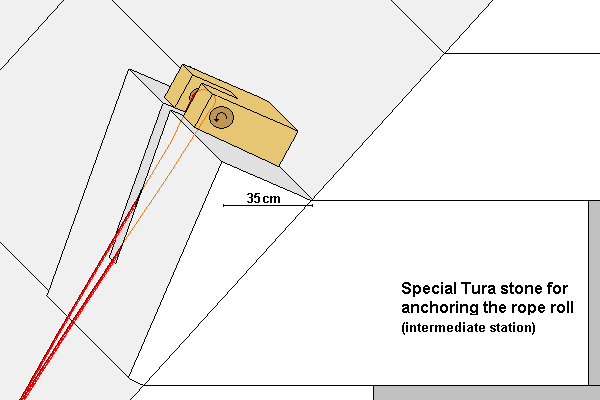
Some outer Tura stones with a special form are left protruding
every 30-37m. They are angled up in such a way, that the rope rolls can
be laid atop and then tied down either with ropes or with a wooden casing
(ropes are not shown on this illustration). They have to be specially
well interlocked with the wall to distribute the load. A slit is chiseled
into the stone just underneath the rope roll, so the rope can be directed
down to the sledge. Illustration
alternative how the achoring stone could look like.
![]() Transport up the pyramid flank with
Löhner's rope roll
Transport up the pyramid flank with
Löhner's rope roll
Pyramidion
The uppermost piece or capstone of a pyramid is called "pyramidion"
(plural pyramidia). The pyramidion of a large pyramid such as the pyramid
of Khufu weighted around 5 to 6 tons, was made from Tura limestone, granite
or diorite and was perhaps gold plated [2]. This
stone had to be cut to measure (taking into account, that slight errors
in measurement might have occurred and the top of the pyramid was not
exactly centered), specially burnished and polished.
![]() Transporting the pyramidion to the top of
the pyramid
Transporting the pyramidion to the top of
the pyramid
 Hiding the entrance to the pyramid of Khufu
Hiding the entrance to the pyramid of Khufu
It is not known, if a corpse was ever buried inside the pyramid of Khufu. So it is also not clear, if the entrance to the pyramid was closed when the pharaoh Khufu died or if closing the passage was done during the construction or later after the pyramid was finished building.
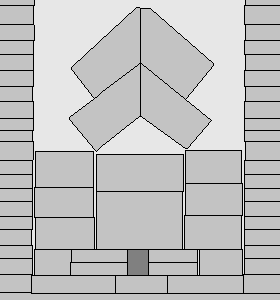
Massive stones of the entrance passage of the pyramid of Khufu [2] as seen today
The entrance or - if we take the view of the pharaoh - the exit of the pyramid of Khufu doesn't lie in the exact middle of the northern pyramid flank but is offset by 7.29m to the east on used to be on 16.76m [6] height (19th course- a specially thick stone layer), today it is at 13.71m (16th course) and several meters back from the pyramid face . It was entirely covered with Tura casing blocks, until those blocks were taken away for the purpose of building houses in Cairo.
The exact point in time when the actual entrance was found is not clear. There is an entrance underneath, probably cut by grave robbers but perhaps the caliph Abd Allah al-Mamun forced his way into the pyramid in 820 AD. It is interesting, that the tunnel connects directly to the descending corridor, circumventing the large granite stones blocking the way in. This could signify, that somebody dug the tunnel, who knew quite well about the system of passages inside the pyramid. Probably the caliph only enlarged the tunnel. Photo entrance to the pyramid of Khufu / Photo 2 / Illustration
 Outer casing stones of Khafre's pyramid
Outer casing stones of Khafre's pyramid
Khafre's pyramid has still most of its outer stones in place on the top. Part of the "casing" seems to hang in midair since centuries, because the lower stones were removed. Even in 1639 the British John Greaves wrote, that the outer casing stones of Khafre's pyramid were intact except on the southern face [5]. This shows, that the ancient Egyptians interlocked the outer stones most thoroughly with the inner stones.
The outer surface of Khafre's pyramid can be divided into three parts - on the very top there are intact Tura stones (about 70 to 90 stone courses) which then abruptly break off, then an area which lies like a belt just underneath the Tura stones where the outer stones are missing. Not only the Tura stones but approximately three stone layers lying just underneath are also missing. This can seen specially well at the northeastern corner, where the ridge brakes off vertically. Under this belt there is a third area where the stones are rougher and irregularly cut off. A possible explanation could be, that the entire area just underneath the intact surface slid down all at once when too many of the supporting stones underneath were quarried or for example during a earth quake.
You would expect, that a pyramid would be constructed with thick stoneslayers
at the bottom and thin courses at the top. Bit it is interesting to notice,
that again and again there are thicker stone courses, some quite high
up on the pyramid. This fact was also noticed at Khufu's pyramid.
![]() Stone courses of the Pyramid of
Khufu
Stone courses of the Pyramid of
Khufu
 Mantle or integral part?
Mantle or integral part?
 To
build a slope, different techniques can be used. Existing masonry can
be trimmed, you bevell off the protruding parts of the
stones and get a slope. Or you can add a casing to the
core masonry, and obtain a slope like that. Here the term "mantle"
can be used, because the stones are only added after finishing the whole
building. Or you can plan the building, so stones integrated into
the masonry form a slope. All stones are bevelled to a precise
angle and layed down in such a way, that they are interlocked with the
other stones and anchored.
To
build a slope, different techniques can be used. Existing masonry can
be trimmed, you bevell off the protruding parts of the
stones and get a slope. Or you can add a casing to the
core masonry, and obtain a slope like that. Here the term "mantle"
can be used, because the stones are only added after finishing the whole
building. Or you can plan the building, so stones integrated into
the masonry form a slope. All stones are bevelled to a precise
angle and layed down in such a way, that they are interlocked with the
other stones and anchored.
Franz Löhner thinks, that the outer casing stones were transported up Khufu's pyramid and put in their intended place at the same time as the stones for the core and then were burnished and polished. The outer Tura stones were an integral part of the pyramid structure, that is to say they were interlocked and bonded with the core stones and not used to encase the structure like a mantle or skin. (The following illustrations are not drawn to the same scale)
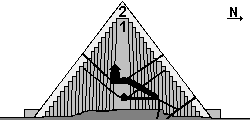 In
literature about the pyramids you still find illustrations of the pyramid
of Khufu with the so called pyramid core and an outer mantle,
even by people knowledgeable in Egyptian architecture [2
and 7]. According to these theories the core of
the pyramid was build first (1 on the graphic) and then
a mantle or outer shell (2) was added. Considering the
great height of the pyramid of Khufu, we think, that if the outer stones
were a shell around the inner core, then the outer shell would start sliding
down, because the weight is too large and the stones are not anchored
enough. This probably would have happened already while building. Anyway,
a core with vertical tiers has been found neither in Khufu's nor in Khafre's
pyramid. This kind of inner core should be visible at least at the top
of the Khafre pyramid, where only 9 stone layers have been removed. Illustration
of the upper layers of Khufu's pyramid.
In
literature about the pyramids you still find illustrations of the pyramid
of Khufu with the so called pyramid core and an outer mantle,
even by people knowledgeable in Egyptian architecture [2
and 7]. According to these theories the core of
the pyramid was build first (1 on the graphic) and then
a mantle or outer shell (2) was added. Considering the
great height of the pyramid of Khufu, we think, that if the outer stones
were a shell around the inner core, then the outer shell would start sliding
down, because the weight is too large and the stones are not anchored
enough. This probably would have happened already while building. Anyway,
a core with vertical tiers has been found neither in Khufu's nor in Khafre's
pyramid. This kind of inner core should be visible at least at the top
of the Khafre pyramid, where only 9 stone layers have been removed. Illustration
of the upper layers of Khufu's pyramid.
An argument against an inner core is the fact,
that the stone layers of the pyramid of Khufu vary only about 1-2cm in
thickness. The largest differences are found in the first 15 layers where
the pyramid is built around a rock outcropping and then again at the height
of the ceiling of the King's chamber (course 58-59). The maximal difference
is 10.9 cm in the 12th course [7]. These differences
are evened to 1cm in the following stone courses. Such an accuracy is
only important, if the following stone layers have to lay flush on top
of the previous layer. With a pyramid core and an outer mantle this is
not important - on the contrary, for better stability the small outer
mantel layer should be inclined inwards - see the following example!
![]() Stone courses of the Pyramid of
Khufu
Stone courses of the Pyramid of
Khufu
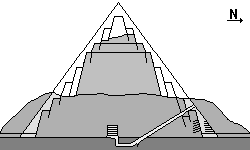 In
Meidum a pyramid probably commissioned by the pharaoh
Huni is located, which was possibly built using the principle of core
and mantle. The pyramid was initially executed as a pyramid with 7 steps,
but perhaps even before it was finished, an eighth step was added. Then
the pharaoh Sneferu continued to change the shape of the pyramid, probably
intending to build a true, smooth sided pyramid [4].
While the stones of the original steps were tilted inwardly, the outer
mantle was build with horizontal stone layers [5].
A theory suggests, that already during construction the outer stones slipped
and parts of the inner steps collapsed. The inner core of the pyramid
still stands but is surrounded by a mountain of rubble. In Zawiyet
el-Aryan lies an other pyramid - now only a stump - which was
also built with a core and a mantle.
In
Meidum a pyramid probably commissioned by the pharaoh
Huni is located, which was possibly built using the principle of core
and mantle. The pyramid was initially executed as a pyramid with 7 steps,
but perhaps even before it was finished, an eighth step was added. Then
the pharaoh Sneferu continued to change the shape of the pyramid, probably
intending to build a true, smooth sided pyramid [4].
While the stones of the original steps were tilted inwardly, the outer
mantle was build with horizontal stone layers [5].
A theory suggests, that already during construction the outer stones slipped
and parts of the inner steps collapsed. The inner core of the pyramid
still stands but is surrounded by a mountain of rubble. In Zawiyet
el-Aryan lies an other pyramid - now only a stump - which was
also built with a core and a mantle.
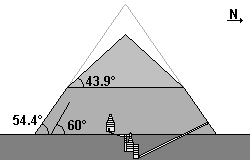 There
is also evidence of structural problems in the Bent pyramid, as can be
observed in the entrance passage, where a 23cm high step is found (photo).
Here the exterior mantle was dislocated from the core because the outer
stones were not interlocked well enough with the core stones.
There
is also evidence of structural problems in the Bent pyramid, as can be
observed in the entrance passage, where a 23cm high step is found (photo).
Here the exterior mantle was dislocated from the core because the outer
stones were not interlocked well enough with the core stones.
This pyramid was first planned and executed with a steep angle of inclination,
then the ground beneath the pyramid gave way. The builders lengthened
the base and a new angle was chosen. Because this didn't solve the structural
problems, the angle was drastically reduced which resulted in much less
overall height. The fact is, that the builders eventually solved the problems,
because the pyramid still stands after several thousand years and the
outer flank still hasn't yet slipped, even after the corner stones were
removed.
![]() Alignment of the pyramids and controlling
the shape of the pyramid
Alignment of the pyramids and controlling
the shape of the pyramid
![]() Photos Khafre
/ Bent
pyramid - Patches
on the outer pyramid flank / Zawiyet
el-Aryan / Meidum
Photos Khafre
/ Bent
pyramid - Patches
on the outer pyramid flank / Zawiyet
el-Aryan / Meidum
 Additional information about the stone courses of the pyramid of Khufu
Additional information about the stone courses of the pyramid of Khufu
- Illustration of the courses of the pyramid of Khufu - the lower 50 stone tiers [6]
- 1. course 1.46-1.49m / 2. course 1.25-1.33m / 3. course 1.15-1.22m / 4. course 1.11-1.13m / 5. course 0.99-1.03m / 6. course 0.97-1.06m / 7. course 0.99-1.12m / 8. course 0.89-0.96m / 9. course 0.87-0.93m / 10. course 0.82-0.96m [2]
- Thick stone courses (more than 90cm high, the thinnest stones courses are 51.5cm high): 1 to 10 / 19 / 35 to 38 / 44 to 45 / 47 to 48 / 90 to 91 / 98 to 100 / 118 / 201 [3]
- The whole pyramid consisted of 210 stone courses, and even just underneath the apex (tip) on the 201st course, large and heavy stones (1.12m = 2 Ellen) were used [4]. This fact strongly speaks against the use of transport ramps, because with those it is imperative that towards the top only smaller stones are hauled up the ramp, since it is getting much smaller there.
- Average height of the stone blocks is 0.69m, the height most commonly used was 0,60m = 8 palm [3]
 Sources
Sources
[1] V. Maragioglio und C. Rinaldi
Architettura delle Piramidi Menfite. Le grande piramide di Cheope
[2] D. Arnold Building in Egypt
[3] G. Goyon Die Cheops-Pyramide
[4] R. Stadelmann Die grossen
Pyramiden von Giza
[5] M. Lehner Geheimnis der Pyramiden
[6] W. Petrie The Pyramids and
Temples of Gizeh
[7] L. Borchardt Einiges zur
dritten Bauperiode der grossen Pyramide bei Gise
www.cheops-pyramide.ch Copyright 2006 Franz Löhner and Teresa Zuberbühler

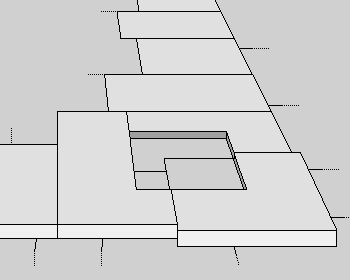 Lower
stone layers
Lower
stone layers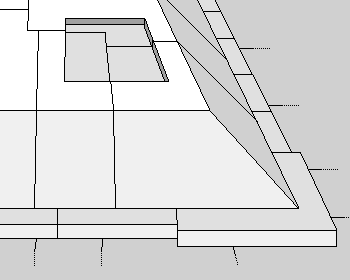 Corner
stones
Corner
stones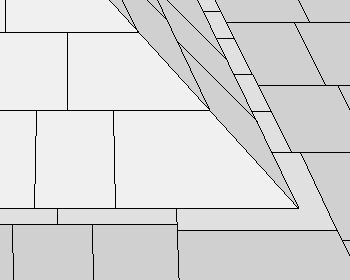 Additionally
the stones were also slightly tilted inwards [
Additionally
the stones were also slightly tilted inwards [